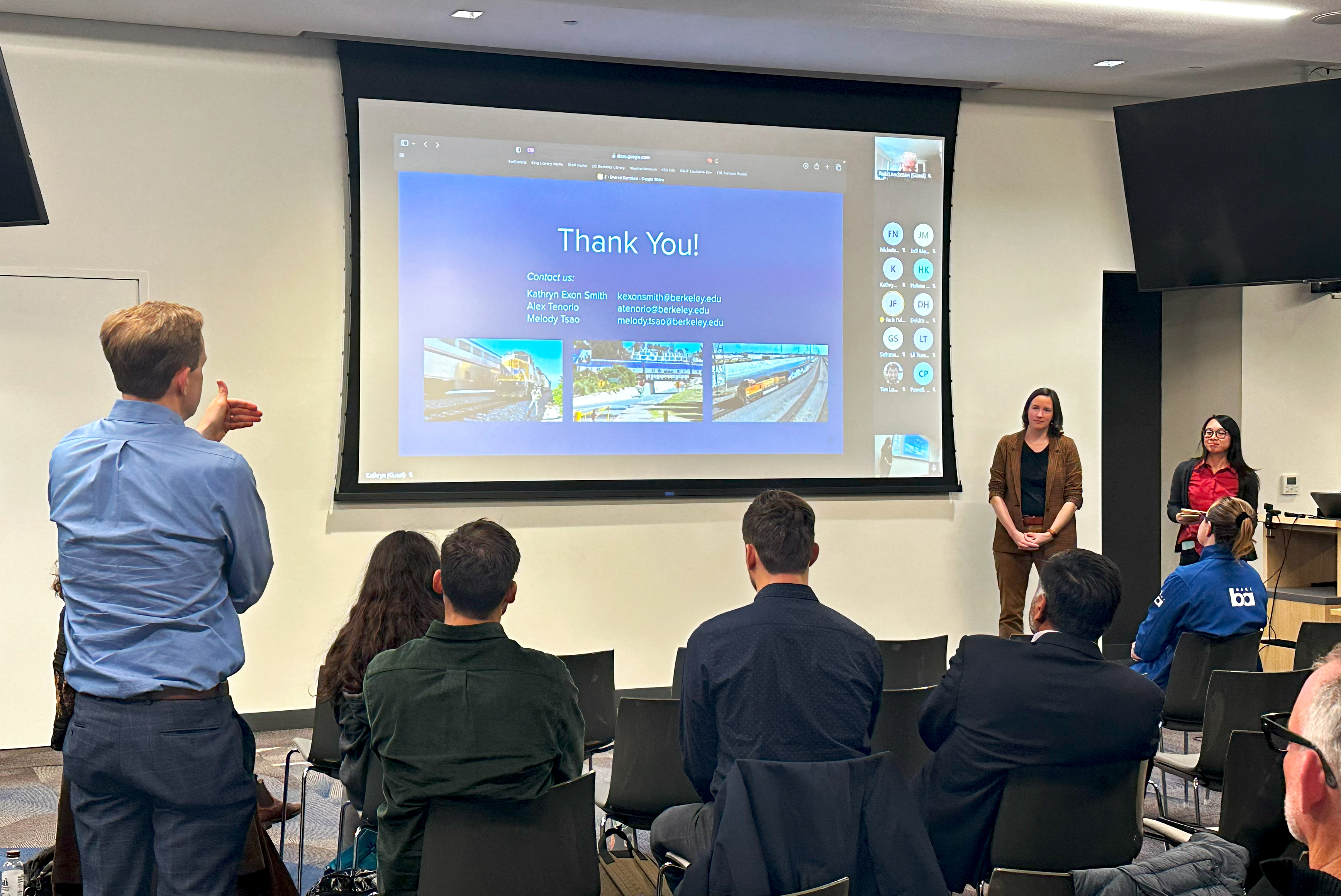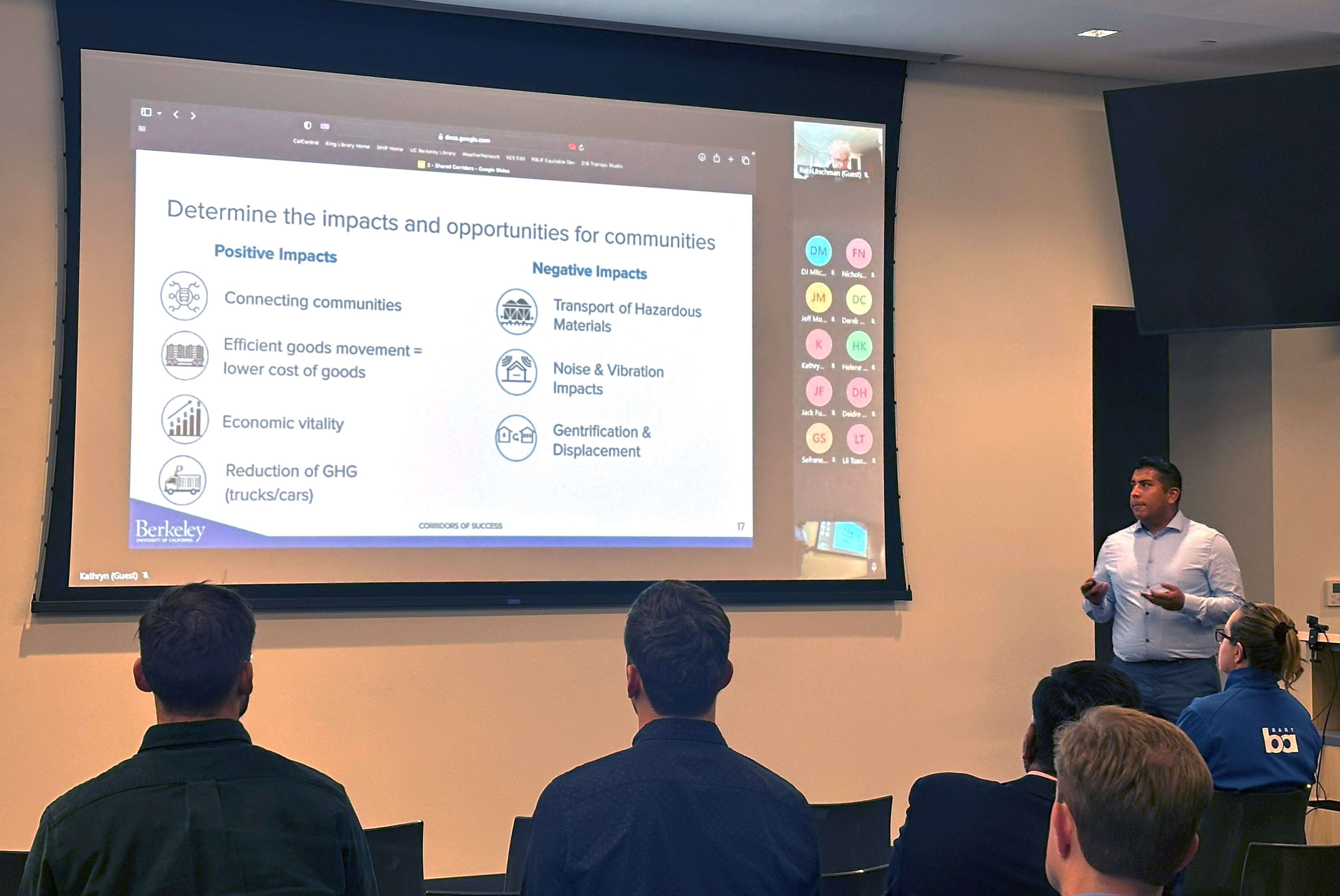UC Berkeley City Planning Students Link Solutions to Program
The UC Berkeley’s College of Environmental Design’s Transportation and Land Use Studio, led by professor Karen Trapenberg Frick, provides Master of City Planning candidates with the opportunity to work with BART and Link21 Team members on several research topics to improve planning efforts.
The Link21 Team proposed a series of potential research topics, such as possible improvements in equity, system resiliency, and efficiency, then collaborated with students to develop the topics chosen. The three student teams selected an equity assessment tool, an Oakland station siting analysis, and freight and passenger service efficiency improvements as their topics. The students spent weeks reviewing case studies, conducting research, and interviewing several subject matter experts to form the basis of their projects.
Students then presented their results in November 2023 to BART's General Manager Robert Powers, Capitol Corridor's Managing Director Rob Padgette, and Link21 Team members: Program Director Sadie Graham, Program Evaluation Manager Andrew Tang, and Engagement & Outreach Manager Nicole Franklin. Questions were posed, and suggestions offered on how work could be expanded and findings implemented.

Capitol Corridor Joint Powers Authority Managing Director Rob Padgette provides feedback to the UC Berkeley Transportation Planning Studio on the collaboration required between passenger and freight service.
We are all so impressed by the research produced by these students on Link21. With this collaboration between UC Berkeley and the Program, we’re incorporating critical viewpoints from the youth and students who will see the benefits of the improvements in the future.
- Link21 Program Director Sadie Graham
Among the projects the students produced was a Transportation Insecurity Assessment Tool that processed census tract data and analyzed residents’ access to opportunities, such as jobs and healthcare, against socio-economic barriers.
Edna Aguilar is a dual-track Master of Transportation Engineering and City Planning student who was a part of the team that produced the tool. “It’s a platform that allows government and transit agencies, and the public to start a conversation. Community members have lived experiences, and understand the needs of their neighborhoods, but don’t always have the data for those experiences. The tool helps agencies and community members come together with the same level of information,” Aguilar said on the tool’s future potential.
The tool analyzes the inputs given on the various opportunities and barriers for each census tract, then provides a map overlay to the tracts for the levels of access to opportunities, socio-economic and historical barriers, and a combination that allows community members and planners to see the relationship between the two.
Master of City Planning candidate Hillary Nguyen Pham explained the tool can be used by agencies for participatory research and with resident input it can be further improved.
It’s so important to include residents in identifying barriers and opportunities.
- Master of City Planning Student Hillary Nguyen Pham
Boths students noted the complexity of tools available to transportation agencies for planning, however they believe their tool can add in the social component so they can better understand insecurity. They also noted their biggest research takeaway was how insecurity can appear differently between cities, and the need to locally contextualize results.
The second project of the studio was a siting study for a potential Link21-based “mega station” at Jack London utilizing community feedback on how to improve local connections between the proposed site and the Downtown Oakland area.
The Jack London area is an important transportation hub for Downtown Oakland with both the Amtrak station and the San Francisco Bay Ferry terminal located in the vicinity. With a potential new station coming to the area under the Link21 Program, students sought to include community feedback and historical context along with planning analysis to best position the station.
Second-year student Angie Chen said one of the exciting draws for the study was the challenge of improving the connectivity between the area and downtown Oakland which is cut off by the Interstate 880.
The freeway is the most fundamental characteristic, for better or for worst, but mostly worst…and we wanted to make the neighborhood whole again.
- Master of City Planning Student Angie Chen
Chen and her team analyzed the various north-south connections which included community feedback that noted the pedestrian and cyclist crossings under the freeway as unpleasant and unsafe both in terms of pedestrian visibility and a lack of lighting for personal safety.
The team identified north-south connections with the greatest potential for access based on an analysis on projected peak period trips using the Institute of Transportation Engineering methodology. “We were kind of surprised that Alice Street as an alignment didn’t rank higher. It was floated originally by the client team (Link21) as it also provided a connection to Regional Rail. However, it was mostly a result of Alice Street having less activity.”
An analysis on walksheds, areas accessible on foot within 10 minutes, further refined their siting selections. In reviewing the benefits trade-offs for the various alignments identified, the students encountered a challenge the Link21 Program will face as the variations were minimal. “If the alignments are within a block or two, it’s difficult to say one performs better than another,” Chen said. Additional work will be needed to adequately evaluate the equity trade-offs, including a review of ADA improvements that could be implemented for each station and street approaches.
“The whole point of the studio is to be creative, like things that normally wouldn’t fly in the real world, but as long as we have the information to back it up, we can propose it,” Chen added.
The final study was a review of current practices between freight rail owners and passenger service agencies in shared use scenarios and how to improve outcomes for the communities they serve.
Alex Tenorio, a second-year Master of City Planning student, noted the difficulty passengers face when their service shares track with freight carriers. “This past week I rode Amtrak twice and yesterday I had issues as we went to the siding to let a freight train pass by,” Tenorio said of his own experience of the interplay between the two services.
In speaking to various subject matter experts in the freight industry and government agencies for rail infrastructure, his study team found that there is a hesitation when it comes to deciding where to invest as freight carriers prefer not to invest in markets less viable to them.
“Southern California is a huge region with a lot of trade and issues, that would be a region to focus on. It has the biggest port in the nation,” Tenorio said. He also noted the importance of such projects such as the Alameda Corridor, a 20-mile freight line connecting the two main ports of Long Beach and Los Angeles with the terminus of the mainlines of BNSF Railway and Union Pacific Railroad near Downtown Los Angeles.
His team’s research noted several areas where passenger rail service and freight line owners could better coordinate, particularly equity and safety, to improve service for both industries. As major freight lines can often travel through urban areas which house distribution hubs, communities along the lines suffer from poor air quality and noise pollution.

Master of City Planning student Alex Tenorio presented the various impacts to communities located along heavy rail lines with freight and passenger rail services.
“One of the points we wanted to drive was having the middle ground where you could coexist, you could keep these financial centers, but you could keep away these negative externalities,” Tenorio said.
In terms of equity initiatives in freight, Tenorio said carriers haven’t caught on to the recent moves across industries to champion equity in their operations.
Their focus on equity is their contribution as being the most environmentally friendly option to moving freight. That’s why we wanted our paper to drive the point that freight needs to drive equity more.
- Master of City Planning student Alex Tenorio
Tenorio said that one way they can improve equity is by working with passenger rail to improve capacity for passenger service, creating more opportunities and access for communities lacking transportation security. Continued funding was identified as an issue in ensuring there are improvements to passenger service on freight tracks. Tenorio noted the funding from the Infrastructure Investment and Jobs Act ends in 2026.
“We learned a lot of lessons from the supply chain issues, congestion in cities. There’s potential to keep funding going and we do see a shift,” Tenorio said on the way to move forward.
He did sense there is a changing perception on what is possible. “A lot of interviewees said if we were looking at this 10 years ago, the answers would have been very different.”
While many of the student researchers are quickly approaching graduation in 2024, some will continue their research projects in order to further improve the tools created and develop more defined recommendations for the Link21 Program. As future planners, the students will encounter many opportunities to assist communities around the world in building more equitable and accessible public transportation systems. Plus, as the Program advances, an opportunity may arise for the students to join the Program team and build on the foundations created together with Link21.




